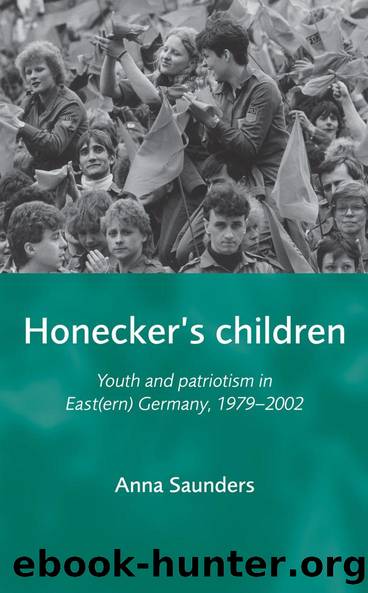Honecker's Children by Anna Saunders

Author:Anna Saunders [Saunders, Anna]
Language: eng
Format: epub
Tags: History, Europe, Germany, Modern, 20th Century, World
ISBN: 9780719082139
Google: YarIyAEACAAJ
Barnesnoble:
Goodreads: 12698143
Publisher: Manchester University Press
Published: 1958-10-02T00:00:00+00:00
Hope of a reformed socialism: 9 Octoberâ9 November 1989
In the month prior to the fall of the Berlin Wall, two clear trends emerged amongst the young population. The first had begun weeks before the onset of mass demonstrations, increasing in intensity towards 9 November: flight from the GDR. The second developed during this month: the desire to stay and work for an improved, reformed GDR. Both represented hope of better things to come, and above all, escape from an ever-more depressing reality.
Those who fled the GDR sought a better standard of life and improved future prospects in West Germany, where, as âGermanâ citizens, they automatically received FRG passports. The proportion of young people amongst those who left was particularly high, with estimates that as many as 80% of those leaving the GDR in 1989 were under 30,20 many of whom were skilled workers with a good chance of finding employment in the West and few binding commitments in the GDR.21 Alongside the usual complaints concerning inadequate accommodation, unattractive youth activities and goods shortages, the SEDâs continuing refusal to undertake reform pushed increasing numbers of young people into the arms of the West. Eberhard Aurichâs statement in Junge Welt, for example, that the Rock Musiciansâ Resolution of 18 September (which called for clear reform) should not be discussed at FDJ events, provoked a flood of angry letters to the newspaper.22 Many also complained that, having written an âhonest expression of opinionâ in Staatsbürgerkunde as requested, they were graded with a 5 (fail).23 Fearful that real reform would never take place in the GDR, many fled, leaving behind friends and relatives, and renouncing all loyalty to the concept of socialist patriotism.
The flight of growing numbers of East Germans provoked an increasingly resolute reform movement amongst the large number that remained, with ever-more young people becoming proactive in the battle to create a truly democratic socialism. As the ZIJ found in November 1989, 88% of young people desired a reformed, socialist GDR, but only 5% opted for a capitalist solution.24 Socialism clearly offered young people some benefits which could not be secured under capitalism, such as full employment and comprehensive social security. This is not to say that those who stayed were unaware of the problems in the East, and many wanted these to be openly discussed: âI think we should first deal with the problems in the GDR, and not unemployment in the FRG. We should be able to say honestly and concretely what is wrong.â25 Many letters sent to the FDJ were, indeed, directed against the glossy images of SED propaganda, and indicated a strong desire to clean the slate and establish a true basis on which reform could take place, thereby creating a country in which one could take real pride, rather than a fictional world created by SED functionaries. The question of unification not only remained taboo during this month, but was largely considered impossible, and the GDR of the future thus remained a state worth working for in the minds of many who stayed.
Download
This site does not store any files on its server. We only index and link to content provided by other sites. Please contact the content providers to delete copyright contents if any and email us, we'll remove relevant links or contents immediately.
| Anarchism | Communism & Socialism |
| Conservatism & Liberalism | Democracy |
| Fascism | Libertarianism |
| Nationalism | Radicalism |
| Utopian |
The Secret History by Donna Tartt(16622)
The Social Justice Warrior Handbook by Lisa De Pasquale(11489)
Thirteen Reasons Why by Jay Asher(7788)
This Is How You Lose Her by Junot Diaz(5770)
Weapons of Math Destruction by Cathy O'Neil(5036)
Zero to One by Peter Thiel(4824)
The Myth of the Strong Leader by Archie Brown(4789)
Promise Me, Dad by Joe Biden(4447)
Beartown by Fredrik Backman(4415)
Stone's Rules by Roger Stone(4415)
How Democracies Die by Steven Levitsky & Daniel Ziblatt(4398)
The Fire Next Time by James Baldwin(4342)
100 Deadly Skills by Clint Emerson(4076)
A Higher Loyalty: Truth, Lies, and Leadership by James Comey(4032)
Rise and Kill First by Ronen Bergman(4012)
The David Icke Guide to the Global Conspiracy (and how to end it) by David Icke(3881)
The Farm by Tom Rob Smith(3872)
Secrecy World by Jake Bernstein(3782)
The Doomsday Machine by Daniel Ellsberg(3730)
